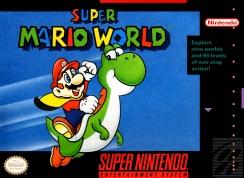Super Mario World is a two-dimensional platform game in which the player controls the on-screen protagonist (either Mario or Luigi) from a third-person perspective. The game shares similar gameplay mechanics with previous titles in the series—Super Mario Bros., Super Mario Bros. 2, and Super Mario Bros. 3—but introduces several new elements. In addition to the running and jumping moves found in past games, the player can float with the aid of special items and execute new types of jumps such as the spin jump. The player navigates through the game via two game screens: an overworld map and a sidescrolling playfield. The overworld map displays an overhead representation of the current world and has several paths leading from the world's entrance to a castle. Paths connect to action panels, fortresses, ghost houses and other map icons, and allow players to take different routes to reach the world's goal. Moving the on-screen character to an action panel or fortress will allow access to that level's playfield. The majority of the game takes place in these levels, populated with obstacles and enemies, with the player traversing the stage by running, jumping, and dodging or defeating enemies. The player is given a certain amount of lives, which are lost when Mario is attacked by an enemy while small, falls into a pit or lava, or runs out of time. If all lives are lost at any point in the game, the "Game Over" screen will appear, in which the player can continue from the last level played by selecting "Continue". Each world features a final stage with a boss to defeat; each of the seven worlds feature fortresses controlled by one of the Koopalings, and the player also battles Bowser in his castle in the seventh world. In addition to special items from previous games like the "Super Mushroom" and "Fire Flower", new power-ups are introduced that provide the player with new gameplay options. In addition, the "Spin Attack" jump is initiated with the "A" button. The spin attack allows Mario or Luigi to break blocks beneath him. The new suit in the game is the cape feather, which gives Mario a cape and allows him to fly. This suit is also similar to the Tanooki Suit from Super Mario Bros. 3 in terms of gameplay mechanics but with a few alterations: the player can now hold the B button to fly when Mario is able to do so, and can glide using the cape as a sail. However, the Super Leaf, Tanooki Suit, Frog Suit, and Hammer Suit power-ups from Super Mario Bros. 3 did not return. The game also introduced the ability to "store" an extra power-up in a box located at the top center of the screen. For example, if Super Mario obtains a Fire Flower or Cape Feather or picks up another Super Mushroom, a Mushroom is stored in the box. If Cape Mario finds a Fire Flower, a Cape Feather will be stored in the box. The power-up can be released by pressing the Select button or will automatically deploy if Mario is hit by an enemy. The game introduces Yoshi, a dinosaur companion whom Mario can ride and who is able to eat most enemies.[2] If Yoshi attempts to eat a Koopa or its shell, he will hold it in his mouth for a period of time before swallowing it; Yoshi can also spit out the shell, which will behave as if kicked by Mario. Yoshi gains special abilities while holding a colored shell in his mouth: a blue shell enables Yoshi to fly, a yellow shell causes Yoshi to emit dust clouds that kill nearby enemies, and a red shell allows Yoshi to produce three fireballs. Flashing Koopa shells produce all three abilities, while green shells produce none. The default Yoshi is green, but the game also contains blue, yellow, and red Yoshis; the player can obtain each Yoshi by finding its egg in Star World and feeding enemies to it until it matures. When holding any Koopa shell in its mouth, a Yoshi gains the ability that corresponds to its own color, in addition to that of the shell. Super Mario World includes a multiplayer option which allows two players to play the game by alternating turns at navigating the overworld map and accessing stage levels; the first player controls Mario, while the other controls Luigi. Although Mario and Luigi must generally navigate through seven worlds to reach the end of the game, the player can beat the game much faster by using the Star Road routes. In addition, there are a number of levels that have hidden exits, so Mario can navigate Bowser's castle in several ways. Furthermore, the exploration of these secret stages can lead to other stages, such as Special World. Completion of Special World permanently alters some sprites and the overworld map's color scheme.
 Settings
Settings
 Affiliates
Affiliates
 Promotions
Promotions
 Live Support
Live Support
 Connections
Connections
 Activity
Activity
 My Items
My Items
 My Blogs
My Blogs
 My Photos
My Photos
 My Comics
My Comics
 My Audios
My Audios
 My Videos
My Videos
 My Friends
My Friends
 My Database
My Database
 My Personas
My Personas
 Saved Posts
Saved Posts
 Pages
Pages
 Blogs
Blogs
 Games
Games
 People
People
 Comics
Comics
 Movies
Movies
 Groups
Groups
 Events
Events
 Market
Market
 Webcams
Webcams
 Role Play
Role Play
 Talk City
Talk City
 Database
Database
 Role Personas
Role Personas

